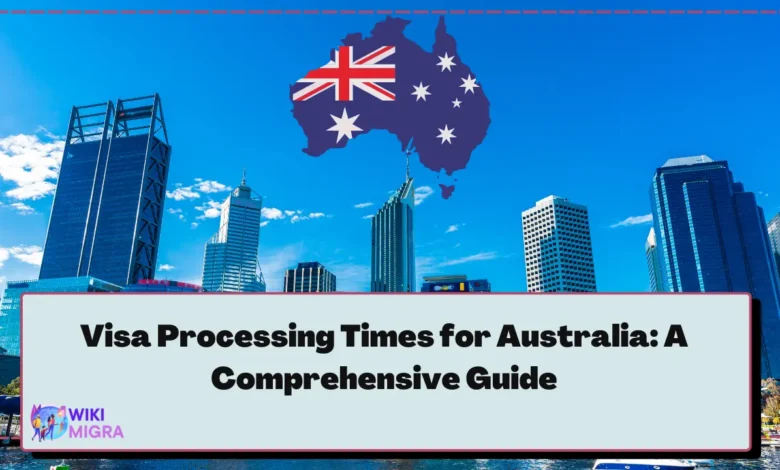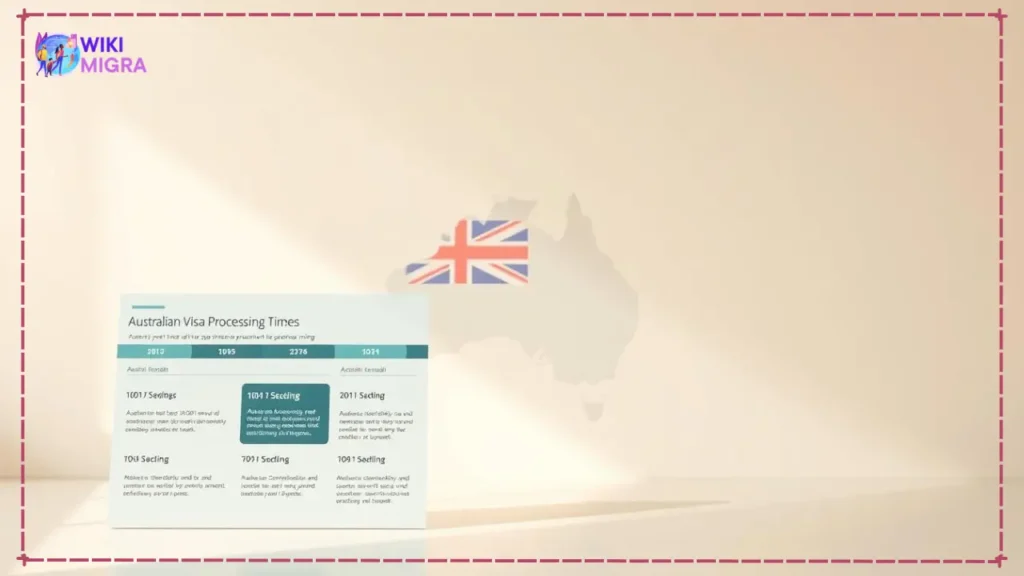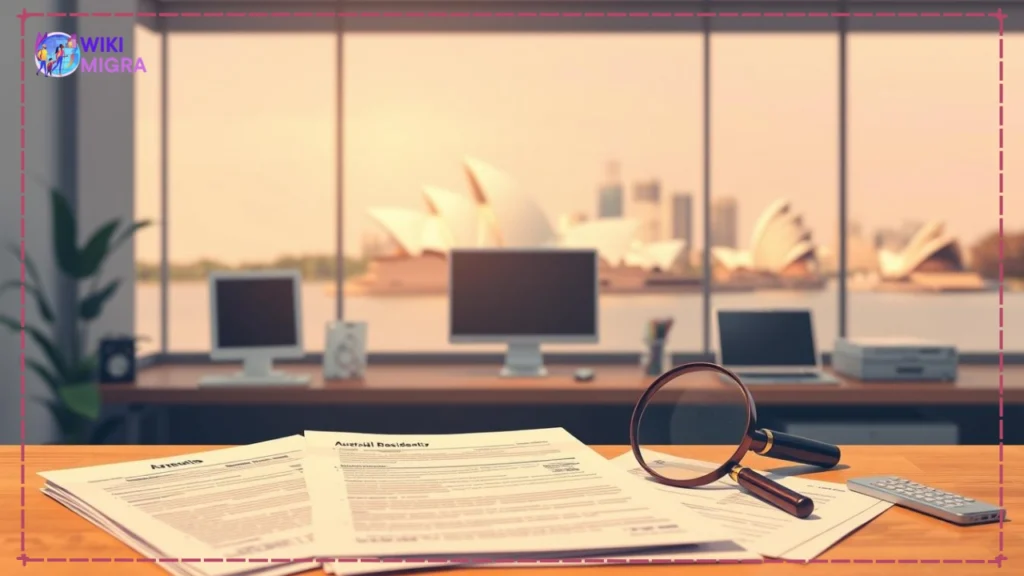Visa Processing Times for Australia: A Comprehensive Guide

Are you planning a trip to Australia and worried about visa delays? Knowing visa processing times australia is crucial to avoid surprises. The australian visa processing system is changing, and many miss out on factors that can make wait times longer than expected. This guide helps clear up the confusion, showing you how to deal with immigration processing times for various visa types.

Understanding Australian Visa Processing Systems
Visa applications in Australia go through a detailed system for accuracy and security. The Department of Home Affairs checks each application in stages. This helps applicants know what to expect and how to speed up their process.
How the Department of Home Affairs Processes Applications
Applications go through four main steps: initial assessment, document review, background checks, and final approval. Each step makes sure the applicant meets the requirements. For instance:
- First, they check if the form is filled out correctly and if the fees are paid.
- Then, they look at documents like passports and financial statements.
- Next, they do security checks on criminal, health, and citizenship history.
- Finally, they make a decision and send it via email or online.
Digital vs. Paper Applications
Choosing digital submissions makes things faster. Electronic applications can cut down processing time by up to 30% compared to paper. They offer real-time tracking and instant document uploads. But, paper applications take longer because they need to be mailed.
The Role of Biometrics in Processing
Biometric data like fingerprints and photos are needed for most visas. US applicants can go to US-based centers for biometric checks. Doing this early helps avoid delays in getting your visa.
Current Visa Processing Times Australia: 2025 Overview
To provide an accurate overview of visa processing times in Australia for 2025, it is essential to consider the most recent updates and data from authoritative sources. The Australian government has made significant efforts to streamline visa processing times across various categories, including skilled migration, family sponsorships, student visas, and visitor visas. Below is a detailed breakdown of the current visa processing times based on available information.
Key Factors Influencing Visa Processing Times
Visa processing times in Australia are influenced by several factors:
- Application Completeness: Missing or incomplete documentation can lead to delays.
- Volume of Applications: Seasonal peaks or policy changes can increase application volumes.
- Visa Subclass Complexity: Some visas require more extensive assessments (e.g., health checks, character tests).
- Government Priorities: Certain visa types may be prioritized based on labor market needs or economic goals.
- Technological Advancements: New systems have been introduced to improve efficiency but may temporarily affect timelines during implementation.
General Processing Times for Key Visa Categories in 2025
Skilled Migration Visas
- Skilled Independent Visa (Subclass 189):
- 50% of applications processed within 74 days.
- 90% of applications processed within four months.
- Skilled Nominated Visa (Subclass 190):
- Processing time varies significantly depending on state nomination and demand.
- Currently, most applications are finalized within 19 months.
- Skilled Work Regional (Provisional) Visa (Subclass 491):
- Processing times range between 18 and 22 months, depending on individual circumstances.
Family Sponsorship Visas
- Partner Visas (Subclasses 820/801):
- These visas often take longer due to detailed relationship assessments.
- Current processing times are:
- 50% of applications processed within nine months.
- 90% processed within 18 months.
Student Visas
- Student Visa (Subclass 500):
- Processing times depend on the education sector and completeness of the application.
- 50% of applications processed within ten days.
- 90% finalized within four months, especially during peak periods.
- Processing times depend on the education sector and completeness of the application.
Visitor Visas
- Visitor Visa (Subclass 600):
- Processing times vary by stream and country of origin:
- Tourist Stream:
- Online applications are generally faster.
- Most decisions are made within seven to ten days for straightforward cases.
- Tourist Stream:
- Priority options may be available for urgent travel needs.
- Processing times vary by stream and country of origin:
Temporary Skill Shortage (TSS) Visas
- Subclass 482 Temporary Skills Shortage – Medium-Term Stream:
- Average processing time is now approximately 61 days, reflecting improvements from previous years.
Recent Improvements in Visa Processing Efficiency
The Australian government has implemented several measures to enhance visa processing efficiency in response to workforce shortages and increased demand for migration pathways:
- Additional funding ($18.3 million) allocated in the Federal Budget for migration system reforms.
- Hiring additional staff at the Department of Home Affairs.
- Introduction of streamlined online systems for faster application submissions.
- Prioritization of high-demand occupations under Ministerial Direction No.105.
Fastest Processed Visas in Australia (2025)
Some visa categories have seen remarkable improvements in processing speeds:
- Visitor Visas and Working Holiday Maker Visas: Approved in less than one day for many applicants.
- Student Visas: Finalized within an average timeframe of just one month.
In summary, Australian visa processing times in 2025 vary widely depending on the type of visa applied for, with some categories experiencing significant improvements due to government reforms and technological advancements. Skilled migration visas typically take between two to twelve months, while family sponsorships may extend up to two years. Visitor and student visas are among the fastest processed categories, with decisions often made within weeks or even days for straightforward cases.
Sources:
- Australia PR Avenue
- The Migration Blog
- Sable International
- Terra Tern Blog
- Holding Redlich Update
- Australia Migrate News
Factors Affecting Your Visa Processing Duration
Many things can change how long it takes to process your Australia visa. Knowing these can help you avoid delays and make your application smoother.
Completeness of Application
Missing information or documents can cause visa processing delays. US applicants often forget important details:
- Outdated passports expiring within 6 months
- Lack of financial proof for travel or study
- Uncertified translation of non-English documents
Peak Season Considerations
| Season | Australia Visa Waiting Period |
| Summer Travel Rush (Dec-Feb) | +2-4 weeks |
| Academic Terms (Feb, July) | +1-3 weeks |
Apply 3-6 months before your trip to miss the busy Australia visa waiting period times.
Health and Character Assessments
Medical exams and police clearances take 2-4 weeks. If you have health issues, you might need extra reports. Security checks can add 30+ days to your wait.
Country of Origin Impact
US citizens usually get their visas faster because of good relations with Australia. But, everyone gets checked. The rules differ by country, but US applicants rarely get turned down because of where they’re from. Still, background checks are a must.
Visitor Visa Processing Timeframes
Knowing estimated visa processing times is key to planning your trip. Australia’s visitor visas have different needs and wait times. So, it’s important to look at each option carefully:
Tourist Visa (Subclass 600)
This visa takes 1–3 months to get approved. You’ll need to show travel plans and have enough money. The cost starts at $125 AUD. Make sure your documents are complete to avoid delays in visa processing times australia.
eVisitor (Subclass 651)
Eligible travelers get instant approval for stays under 3 months. There’s no fee. It’s perfect for quick business trips or meetings, with no waiting time.
Electronic Travel Authority (Subclass 601)
U.S. citizens get instant approval for the ETA. It costs $20 AUD and is valid for 12 months. It’s for tourism or short business trips, with no paperwork needed.
| Visa Type | Processing Time | Fees | Validity | Use Cases |
| Subclass 600 | 1–3 months | $125 AUD | Up to 12 months | Tourism/visiting family |
| Subclass 651 | Instant | Free | 6 months | Short-term business/stays under 3 months |
| Subclass 601 | Instant | $20 AUD | 12 months | Tourism/business for U.S. citizens |
Always check the latest visa processing times australia on the Department of Home Affairs’ website. Plan your trip based on your visa’s australia visa waiting period to avoid any issues.
You may be interested in: Understanding Points System for Australian Immigration 2025
Student Visa Processing Times and Requirements
US students planning to study in Australia need to know about visa processing duration for the Student Visa (Subclass 500). The visa application processing time changes based on the type of education. Universities usually take 1-2 months, while vocational courses might take 4-6 weeks. English language students often get decisions in 3-5 weeks.
| Education Sector | Average Processing Time |
| Higher Education | 4-8 weeks |
| Vocational Training | 3-6 weeks |
| English Courses | 2-4 weeks |
Australia’s Simplified Student Visa Framework makes immigration processing times faster for eligible US applicants. Key requirements include:
- Confirmation of enrollment from an approved education provider
- Proof of financial capacity covering tuition and living costs
- Valid health insurance meeting visa criteria
It’s important to apply early. Do it 3-4 months before your course starts. This way, you can meet the academic calendar. Applying online through the Department of Home Affairs portal is quicker than paper submissions. Showing strong ties to the US, like a job or property, can also speed up the process.
“Applicants with complete documents see faster processing.” – Australian Department of Home Affairs
Work Visa Australia Waiting Period
Knowing the australia visa waiting period for work visas is crucial for those moving to Australia. Recent visa processing update data shows delays vary widely. This depends on the visa type and individual circumstances.
Temporary Skill Shortage Visa (Subclass 482)
Processing times for the TSS visa depend on your occupation and employer sponsorship. Visa processing delays often occur if labor market testing or job ads face issues. Priority occupations like IT and healthcare may see faster results—sometimes under 4 months—if applications are complete.
Working Holiday Visa (Subclass 417/462)
US citizens apply for the subclass 462, which typically takes 3–6 weeks. This visa’s streamlined process avoids many delays seen in other categories, making it a top choice for young professionals. Check requirements like age limits and health/character checks before applying.
Skilled Migration Visas
Skilled visas involve multi-stage processes adding to the australia visa waiting period. For example, Global Talent visas may take 6–12 months due to complex eligibility checks. Employers or state nominations can reduce delays but require strict documentation compliance.
“Applicants with approved SkillSelect Expression of Interest (EOI) scores often see faster processing,” notes the Department of Home Affairs.
- Temporary Skill Shortage visas average 4–8 months
- Working Holiday visas processed in 26–35 days
- Skilled visas vary from 6 months to 1+ years
Plan ahead by submitting clean applications and monitoring visa processing update portals. Employers with labor agreements can fast-track critical roles like nurses or IT specialists. Stay proactive to minimize delays and align your timeline with job start dates.
Family and Partner Visa Processing Expectations
Family and partner visas need more checks, so they take longer than others. Partner visas have two steps: first, a provisional approval, then permanent residency after two years. Onshore applications take 12–18 months, while offshore ones can take up to 24 months.
Parent visas usually take 24–48 months because of high demand. Child visas depend on how complete the custody documents are.
- Provisional Partner Visa (Subclass 820): 10–14 months on average.
- Parent Visa (Subclass 103): Current visa application processing queues add years, but priority is given to health/character cleared applicants.
- Child visas: Expedited if biological parent is an Australian citizen.
US applicants must show a real relationship with financial records, shared housing, or travel history. This helps avoid delays. Costs can add up over time, but bridging visas like Subclass 590 allow work rights during visa processing duration.
Recent policy changes help by prioritizing those with all documents ready. This cut wait times by 15% in 2025.
“Documentation completeness is critical to avoiding additional security checks,” states the Department of Home Affairs’ 2025 visa bulletin.
Applicants overseas can check their status online. For urgent needs, like medical emergencies, contact the US Australia embassy. Planning for longer visa processing times australia makes the transition smoother when approvals come.
Permanent Residency Visa Application Processing
Understanding Australia’s permanent residency paths is key. Recent updates have changed processing times for skilled, sponsored, and family visas. US applicants need to consider these times when planning to move.

Points-Based Skilled Visas
- Two-step process: EOI submission followed by formal application
- Processing times average 12–24 months
- Priority for IT, healthcare, and engineering roles
Employer-Sponsored Permanent Visas
- Employers must prove local labor shortages
- US applicants with critical skills may see faster processing (8–12 months)
- Streamlined credential evaluations for US qualifications
Family Stream Permanent Visas
- Partner visas require a 2-year provisional period before permanent status
- Recent updates reduced wait times for some categories
- Accurate documentation speeds up processing
Security checks for US citizens add 6–8 months to timelines. Keep track of your case through official channels. This way, you’ll know about any visa processing updates that might affect you.
How to Check Your Visa Application Status
It’s easy to track your visa application. Just log into your ImmiAccount portal. This secure system gives you updates in real-time. Look for messages like “Decision Made” or “In Progress” to see where you are.
In the U.S., the Australian Embassy in Washington, D.C., helps you track your case. Here’s how:
- Log into ImmiAccount and click “Application Status.”
- Check for estimated visa processing timelines next to your application ID.
- Review any system notifications about needed actions or missing documents.
If you see no updates online, contact the Department of Home Affairs Visa Enquiry Service. U.S. applicants can call +61 2 6196 0100 (international rates apply) or email visaenquiries@homeaffairs.gov.au. Always have your application ID and receipt number ready.
“Applications with incomplete forms or missing biometric data may experience delays,” warns the Department of Home Affairs.
For urgent issues, visit the U.S. embassy’s website for appointment slots. Discuss delays in person. Stay proactive by saving all correspondence and noting dates of contact to track responsiveness.
Common Causes of Visa Processing Delays
Knowing why visa applications get delayed is key. It helps applicants steer clear of common mistakes. Let’s look at the main reasons and how to fix them.
Incomplete Documentation
Missing forms or wrong documents cause 40% of delays. US applicants often forget tax returns, work letters, or ID copies. Make sure to check the checklist carefully to avoid a 2-4 week delay.
Verification Procedures
Checking education, work history, and criminal records can take 4-8 weeks. US applicants might face delays if schools abroad take time to confirm. Always follow up on requests quickly.
Security Checks
Background checks using international databases like PEP lists can add 6-12 weeks. Being transparent is crucial—share all needed info early to avoid delays.
COVID-19 Impacts
The pandemic has caused ongoing backlogs, with fewer staff slowing visa processing times australia. Urgent cases get priority, but regular applications might wait 3-6 weeks.
| Issue | Average Delay |
| Incomplete Docs | 2–4 weeks |
| Verification | 4–8 weeks |
| Security Checks | 6–12 weeks |
| Post-Pandemic | 3–6 weeks |
Tips to Potentially Speed Up Your Visa Processing
Start by being precise with your visa application processing. Here are some tips to help you:
- Submit visa processing update-compliant documents early. Make sure you have all the right documents for your visa subclass.
- Apply when visa processing times australia are the shortest. This is usually outside of school holidays or holiday seasons.
- Request priority processing if you can. This is for urgent business or family needs.
Quickly respond to any requests for more information. Slow responses can cause delays. Use the Department of Home Affairs portal to get updates fast.
“Professional guidance can be a game-changer for complex cases. Agents familiar with Australia’s systems can identify shortcuts others miss.” – Immigration Lawyer, Sydney
For urgent cases, think about hiring a licensed migration agent. They can help with forms and find ways to speed up your application. Make sure you can use premium services like the Priority Visa Service.
Plan your document preparation. Start collecting financial documents, police certificates, and health reports early. Taking these steps can keep your visa application processing smooth.
Recent Changes to Australia’s Immigration Processing Times
Immigration processing times are changing in Australia. The country is updating its visa systems. Now, visa processing update policies help all applicants, including US citizens. These changes make the australian visa processing process more efficient and clear.

Policy Updates Affecting Timeframes
New rules focus on visas for skilled workers. The Department of Home Affairs has hired more staff to clear up delays caused by the pandemic. Important changes include:
| Change | Impact |
| Backlog reduction targets | Shorter wait times for common visa types |
| Country-specific risk tiers | US applicants benefit from faster reviews |
Digital Transformation Initiatives
Now, 60% of initial checks are automated, reducing delays. Key digital upgrades include:
- Online biometric submission portals
- Electronic document verification
- Real-time status tracking
These tools cut down on manual steps. This fits with Australia’s aim to make immigration processing times simpler. US applicants can now submit forms online, skipping paper delays.
Even with these improvements, complex cases like permanent residency might take longer. It’s important to keep up with australian visa processing updates to stay informed.
Comparing Australia’s Visa Processing to Other Countries
Visa processing times differ a lot between countries. Knowing these differences helps travelers and migrants plan better. Australia’s visa processing times australia for common visas are compared to places like Canada, New Zealand, and the UK. Here are the details:
You may be interested in: Exploring New Zealand Immigration | A Helpful Overview
| Visa Type | Australia | Canada | New Zealand | UK |
| Tourist Visa | 1-2 weeks | 4-6 weeks | 2-3 weeks | 3-4 weeks |
| Student Visa | 1-3 months | 3-6 months | 2-4 months | 2-3 months |
| Work Visa | 2-6 months | 6-8 months | 3-5 months | 3-4 months |
- Australia’s online systems cut wait times compared to Canada’s longer immigration processing times.
- New Zealand and the UK have similar visa processing duration for student visas, but Australia’s eVisa options simplify entry for tourists.
- US applicants often find Australia’s skilled work visa timelines faster than EU destinations.
“Australia prioritizes digital submissions, reducing delays common in paper-based systems,” says the Department of Home Affairs.
For U.S. travelers, Australia’s average visa processing times australia for tourists (14-30 days) are faster than Canada’s 21-42 days. While work visas take longer globally, Australia’s Temporary Skill Shortage Visa often beats UK equivalents by 1-2 months. Research your options carefully—comparing these factors helps set realistic expectations.
What to Do While Waiting for Your Australian Visa
Waiting for your Australia visa doesn’t mean you have to do nothing. Use the australia visa waiting period to get ready for your trip. Start packing essentials early to avoid last-minute stress. Here are some steps to help you prepare.
Preparation Steps for Your Trip
Start with practical tasks to make your arrival smooth:
- Check Australia’s health insurance needs. You might need proof of coverage for public hospitals.
- Look into visa processing delays. Be ready to change your travel plans if needed.
- Learn some basic Australian English phrases. It will help you communicate better.
Documentation to Gather in Advance
| Category | Required Items |
| Financial | Bank statements showing funds for living costs |
| Health | Medical test results if required by your visa subclass |
| Legal | Police clearance certificates for visas requiring background checks |
Travel Planning Considerations
Plan carefully to avoid problems:
- Book flights with easy cancellation options. This way, you can adjust plans if your visa takes longer.
- Choose accommodation with free cancellation policies. Airbnb is a good option.
- Let employers or schools know about possible delays. This helps adjust start dates if needed.
“Flexibility is key. Treat delays as opportunities to refine your plans,” says migration experts.
Stay proactive but careful. Don’t book anything that can’t be changed. Keep an eye on your application status and update your documents as policies change. This way, you’ll be ready to travel as soon as your visa is approved.
Special Considerations for US Citizens Applying for Australian Visas
US citizens applying for Australian visas get a smooth ride thanks to good relations between the two countries. The visa application processing for Americans is quick, with fast security checks and easy paperwork.
- E-3 visas for specialized workers are exclusive to US citizens, offering dedicated pathways.
- Security assessments often proceed quicker due to information-sharing agreements between governments.
- US-issued documents like passports or transcripts are typically accepted without notarization.
Biometric appointments are available at 17 official centers across major US cities, including New York, Houston, and Los Angeles. You can pay with credit cards or checks. Online portals let you track immigration processing times in real-time.
- Applications submitted digitally through ImmiAccount receive priority handling.
- Time zone differences mean email inquiries to consulates may have delayed responses—check status online for updates.
Australian consulates in the US stress the importance of submitting complete applications to avoid delays. While most steps are faster, it’s still important to keep an eye on standard processing times. Make sure to confirm any deadlines for travel or work start dates.
Conclusion: Planning Your Australian Journey Around Visa Timeframes
Planning your trip to Australia begins with knowing visa processing times. Whether you’re a tourist, student, or worker, understanding the waiting period is key. Recent updates show delays can happen due to checks or high demand.
Tourists need to add extra time for their subclass 600 visa. Students and workers should also plan around application deadlines. Families should include extra time in their plans too. Always check official sites like ImmiAccount for updates to avoid surprises.
Digital applications can make things faster. Plan ahead by applying early and double-checking your documents. Stay updated to make the most of your wait time. A timely application means more time to enjoy Australia once you’re approved.





